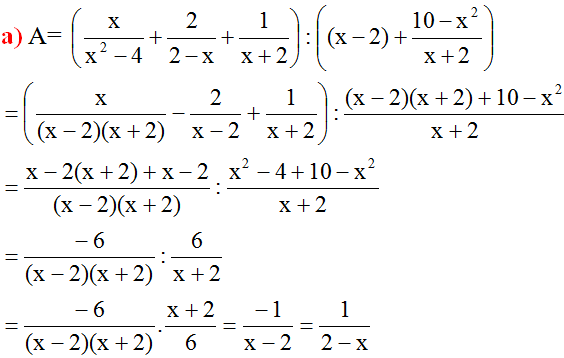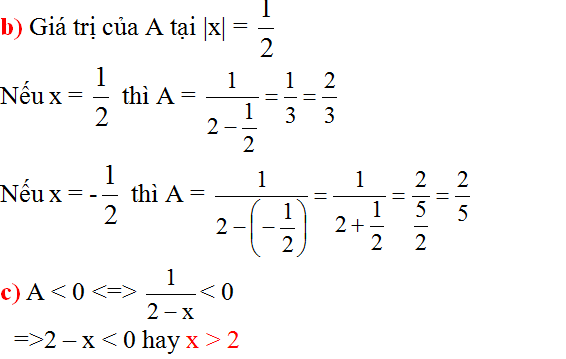Hãy nhập câu hỏi của bạn vào đây, nếu là tài khoản VIP, bạn sẽ được ưu tiên trả lời.

Lời giải của bạn Nhật Linh đúng rồi, tuy nhiên cần thêm điều kiện để A có nghĩa: \(x\ne\pm2\)

a,ĐK: \(\hept{\begin{cases}x\ne0\\x\ne\pm3\end{cases}}\)
b, \(A=\left(\frac{9}{x\left(x-3\right)\left(x+3\right)}+\frac{1}{x+3}\right):\left(\frac{x-3}{x\left(x+3\right)}-\frac{x}{3\left(x+3\right)}\right)\)
\(=\frac{9+x\left(x-3\right)}{x\left(x-3\right)\left(x+3\right)}:\frac{3\left(x-3\right)-x^2}{3x\left(x+3\right)}\)
\(=\frac{x^2-3x+9}{x\left(x-3\right)\left(x+3\right)}.\frac{3x\left(x+3\right)}{-x^2+3x-9}=\frac{-3}{x-3}\)
c, Với x = 4 thỏa mãn ĐKXĐ thì
\(A=\frac{-3}{4-3}=-3\)
d, \(A\in Z\Rightarrow-3⋮\left(x-3\right)\)
\(\Rightarrow x-3\inƯ\left(-3\right)=\left\{-3;-1;1;3\right\}\Rightarrow x\in\left\{0;2;4;6\right\}\)
Mà \(x\ne0\Rightarrow x\in\left\{2;4;6\right\}\)


Vì \(x^2-4x+5=x^2-4x+4+1=\left(x-2\right)^2+1\ge1>0\) với mọi giá trị của \(x\) nên giá trị của biểu thức luôn luôn âm với mọi giá trị khác 0 và khác -3 của \(x\)

d) \(A>0\Leftrightarrow\frac{-1}{x-2}>0\)
\(\Leftrightarrow x-2< 0\) ( vì \(-1< 0\))
\(\Leftrightarrow x< 2\)
\(A=\left(\frac{x}{x^2-4}+\frac{2}{2-x}+\frac{1}{x+2}\right):\left(x-2+\frac{10-x^2}{x+2}\right)\)
\(A=\)\(\left[\frac{x}{\left(x-2\right)\left(x+2\right)}-\frac{2\left(x+2\right)}{\left(x-2\right)\left(x+2\right)}+\frac{x-2}{\left(x-2\right)\left(x+2\right)}\right]\)
\(:\left[\frac{\left(x-2\right)\left(x+2\right)}{x+2}+\frac{10-x^2}{x+2}\right]\)
\(A=\frac{x-2x-4+x-2}{\left(x-2\right)\left(x+2\right)}:\left[\frac{x^2-4+10-x^2}{x+2}\right]\)
\(A=\frac{-6}{\left(x-2\right)\left(x+2\right)}:\frac{6}{x+2}\)
\(A=\frac{-6}{\left(x-2\right)\left(x+2\right)}.\frac{x+2}{6}\)
\(A=\frac{-1}{x-2}\)

a) \(ĐKXĐ:\hept{\begin{cases}x\ne0\\x\ne-5\end{cases}}\)
\(P=\frac{x^2}{5x+25}+\frac{2x-10}{x}+\frac{50+5x}{x^2+5x}\)\(=\frac{x^2}{5\left(x+5\right)}+\frac{2\left(x-5\right)}{x}+\frac{5\left(x+10\right)}{x\left(x+5\right)}\)
\(=\frac{x^3}{5x\left(x+5\right)}+\frac{10\left(x-5\right)\left(x+5\right)}{5x\left(x+5\right)}+\frac{25\left(x+10\right)}{5x\left(x+5\right)}\)
\(=\frac{x^3+10\left(x-5\right)\left(x+5\right)+25\left(x+10\right)}{5x\left(x+5\right)}=\frac{x^3+10\left(x^2-25\right)+25x+250}{5x\left(x+5\right)}\)
\(=\frac{x^3+10x^2-250+25x+250}{5x\left(x+5\right)}=\frac{x^3+10x^2+25x}{5x\left(x+5\right)}\)\(=\frac{x\left(x^2+10x+25\right)}{5x\left(x+5\right)}\)\(=\frac{\left(x+5\right)^2}{5\left(x+5\right)}=\frac{x+5}{5}\)
b) \(x^2-3x=0\)\(\Leftrightarrow x\left(x-3\right)=0\)\(\Leftrightarrow\orbr{\begin{cases}x=0\\x-3=0\end{cases}}\Leftrightarrow\orbr{\begin{cases}x=0\\x=3\end{cases}}\)
So sánh với ĐKXĐ, ta thấy \(x=0\)không thoả mãn
Thay \(x=3\)vào biểu thức ta được: \(P=\frac{3+5}{5}=\frac{8}{5}\)
c) Để \(P=-4\)thì \(\frac{x+5}{5}=-4\)\(\Leftrightarrow x+5=-20\)\(\Leftrightarrow x=-25\)( thoả mãn ĐKXĐ )
Vậy \(P=-4\)\(\Leftrightarrow x=-25\)
d) Để \(P\ge0\)thì \(\frac{x+5}{5}\ge0\)\(\Leftrightarrow x+5\ge0\)( vì \(5>0\))\(\Leftrightarrow x\ge-5\)
So sánh với ĐKXĐ, ta thấy x phải thoả mãn \(x>-5\)và \(x\ne0\)
Vậy \(P\ge0\)\(\Leftrightarrow\)\(x>-5\)và \(x\ne0\)

a) P xác định \(\Leftrightarrow\hept{\begin{cases}2x+10\ne0\\x\ne0\\2x\left(x+5\right)\ne0\end{cases}\Leftrightarrow x\ne\left\{-5;0\right\}}\)
b) \(P=\frac{x^2+2x}{2x+10}+\frac{x-5}{x}+\frac{50-5x}{2x\left(x+5\right)}\)
\(P=\frac{x^2\left(x+2\right)}{2x\left(x+5\right)}+\frac{2\left(x-5\right)\left(x+5\right)}{2x\left(x+5\right)}+\frac{5\left(10-x\right)}{2x\left(x+5\right)}\)
\(P=\frac{x^3+2x^2+2x^2-50+50-5x}{2x\left(x+5\right)}\)
\(P=\frac{x^3+4x^2-5x}{2x\left(x+5\right)}\)
\(P=\frac{x^3+5x^2-x^2-5x}{2x\left(x+5\right)}\)
\(P=\frac{x^2\left(x+5\right)-x\left(x+5\right)}{2x\left(x+5\right)}\)
\(P=\frac{\left(x+5\right)\left(x^2-x\right)}{2x\left(x+5\right)}\)
\(P=\frac{x\left(x-1\right)}{2x}\)
\(P=\frac{x-1}{2}\)
c) Để P = 0 thì \(x-1=0\Leftrightarrow x=1\)( thỏa mãn ĐKXĐ )
Để P = 1/4 thì \(\frac{x-1}{2}=\frac{1}{4}\)
\(\Leftrightarrow4\left(x-1\right)=2\)
\(\Leftrightarrow4x-4=2\)
\(\Leftrightarrow4x=6\)
\(\Leftrightarrow x=\frac{3}{2}\)( thỏa mãn ĐKXĐ )
d) Để P > 0 thì \(\frac{x-1}{2}>0\)
Mà 2 > 0, do đó để P > 0 thì \(x-1>0\Leftrightarrow x>1\)
Để P < 0 thì \(\frac{x-1}{2}< 0\)
Mà 2 > 0, do đó để P < 0 thì \(x-1< 0\Leftrightarrow x< 1\)





a) \(\left(\dfrac{x}{x^2-4}+\dfrac{2}{2-x}+\dfrac{1}{x+2}\right):\left(x-2+\dfrac{10-x^2}{x+2}\right)\)
\(\Leftrightarrow\left(\dfrac{x-2x-4+x-2}{x^2-4}\right):\left(\dfrac{x^2-4+10-x^2}{x+2}\right)\)
\(\Leftrightarrow\left(\dfrac{-6}{x^2-4}\right).\left(\dfrac{x+2}{6}\right)\Leftrightarrow\dfrac{1}{2-x}\)
b) với \(x^2=2x\Leftrightarrow x^2-2x+1-1=0\)
\(\Leftrightarrow\left(x-1\right)^2=1\Leftrightarrow\left[{}\begin{matrix}x-1=1\\x-1=-1\end{matrix}\right.\Leftrightarrow\left[{}\begin{matrix}x=2\left(KTM\right)\\x=0\left(TM\right)\end{matrix}\right.\)
Vậy với x=0 thì A = \(\dfrac{1}{2}\)
c) A nhận giá trị nguyên dương tức \(\dfrac{1}{2-x}\) nhận giá trị dương
Để A nhận giá trị dương thì
\(2-x\inƯ_{\left(1\right)}\)\(\Leftrightarrow2-x\in\left\{-1;1\right\}\)
Vậy x=1 thì A nhận giá trị dương
c) Sửa 1 chút nha: nếu 2-x thuộc ước của 1 thì 2-x=1 (đúng)
hoặc 2-x=-1( như thế thì không phải số dương
=> A không thể dương)
nên ta chỉ nhận 2-x=1 thôi
***có 1 chỗ lập bảng ở phần c) bên bị lỗi nha ******